Junwon Lee
KAD: No More FAD! An Effective and Efficient Evaluation Metric for Audio Generation
Feb 21, 2025Abstract:Although being widely adopted for evaluating generated audio signals, the Fr\'echet Audio Distance (FAD) suffers from significant limitations, including reliance on Gaussian assumptions, sensitivity to sample size, and high computational complexity. As an alternative, we introduce the Kernel Audio Distance (KAD), a novel, distribution-free, unbiased, and computationally efficient metric based on Maximum Mean Discrepancy (MMD). Through analysis and empirical validation, we demonstrate KAD's advantages: (1) faster convergence with smaller sample sizes, enabling reliable evaluation with limited data; (2) lower computational cost, with scalable GPU acceleration; and (3) stronger alignment with human perceptual judgments. By leveraging advanced embeddings and characteristic kernels, KAD captures nuanced differences between real and generated audio. Open-sourced in the kadtk toolkit, KAD provides an efficient, reliable, and perceptually aligned benchmark for evaluating generative audio models.
Sound Scene Synthesis at the DCASE 2024 Challenge
Jan 15, 2025Abstract:This paper presents Task 7 at the DCASE 2024 Challenge: sound scene synthesis. Recent advances in sound synthesis and generative models have enabled the creation of realistic and diverse audio content. We introduce a standardized evaluation framework for comparing different sound scene synthesis systems, incorporating both objective and subjective metrics. The challenge attracted four submissions, which are evaluated using the Fr\'echet Audio Distance (FAD) and human perceptual ratings. Our analysis reveals significant insights into the current capabilities and limitations of sound scene synthesis systems, while also highlighting areas for future improvement in this rapidly evolving field.
Challenge on Sound Scene Synthesis: Evaluating Text-to-Audio Generation
Oct 23, 2024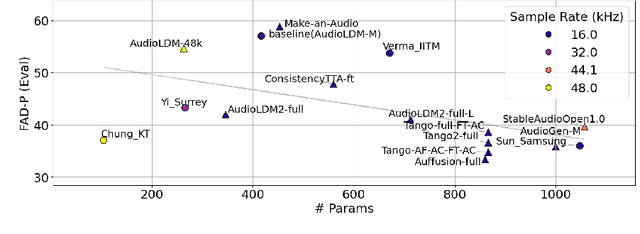

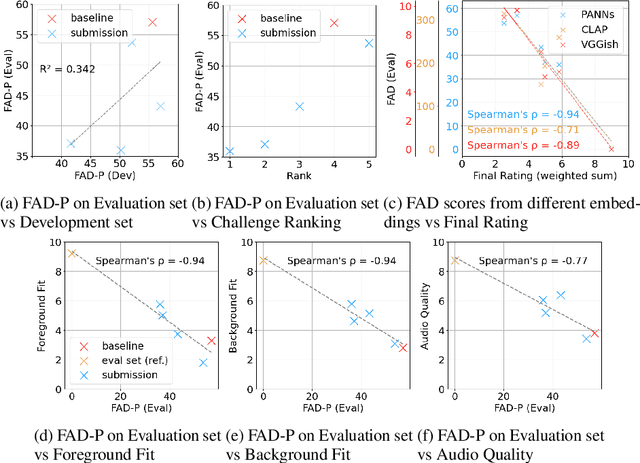

Abstract:Despite significant advancements in neural text-to-audio generation, challenges persist in controllability and evaluation. This paper addresses these issues through the Sound Scene Synthesis challenge held as part of the Detection and Classification of Acoustic Scenes and Events 2024. We present an evaluation protocol combining objective metric, namely Fr\'echet Audio Distance, with perceptual assessments, utilizing a structured prompt format to enable diverse captions and effective evaluation. Our analysis reveals varying performance across sound categories and model architectures, with larger models generally excelling but innovative lightweight approaches also showing promise. The strong correlation between objective metrics and human ratings validates our evaluation approach. We discuss outcomes in terms of audio quality, controllability, and architectural considerations for text-to-audio synthesizers, providing direction for future research.
Video-Foley: Two-Stage Video-To-Sound Generation via Temporal Event Condition For Foley Sound
Aug 21, 2024Abstract:Foley sound synthesis is crucial for multimedia production, enhancing user experience by synchronizing audio and video both temporally and semantically. Recent studies on automating this labor-intensive process through video-to-sound generation face significant challenges. Systems lacking explicit temporal features suffer from poor controllability and alignment, while timestamp-based models require costly and subjective human annotation. We propose Video-Foley, a video-to-sound system using Root Mean Square (RMS) as a temporal event condition with semantic timbre prompts (audio or text). RMS, a frame-level intensity envelope feature closely related to audio semantics, ensures high controllability and synchronization. The annotation-free self-supervised learning framework consists of two stages, Video2RMS and RMS2Sound, incorporating novel ideas including RMS discretization and RMS-ControlNet with a pretrained text-to-audio model. Our extensive evaluation shows that Video-Foley achieves state-of-the-art performance in audio-visual alignment and controllability for sound timing, intensity, timbre, and nuance. Code, model weights, and demonstrations are available on the accompanying website. (https://jnwnlee.github.io/video-foley-demo)
CONMOD: Controllable Neural Frame-based Modulation Effects
Jun 20, 2024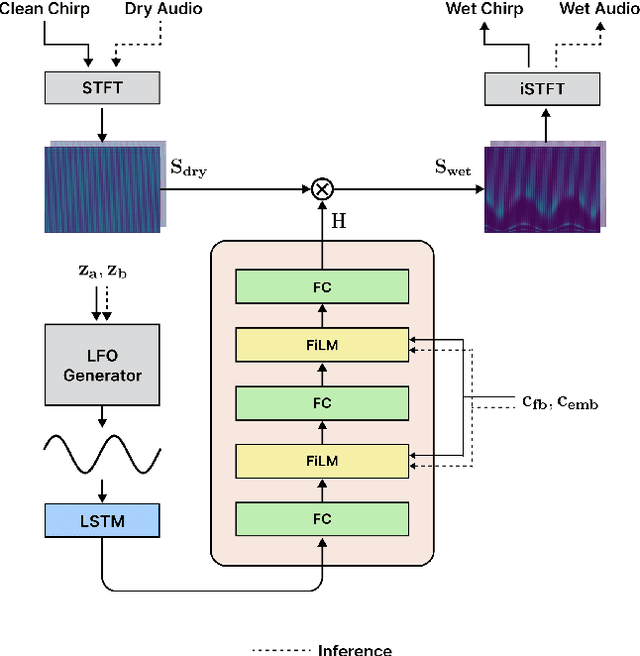
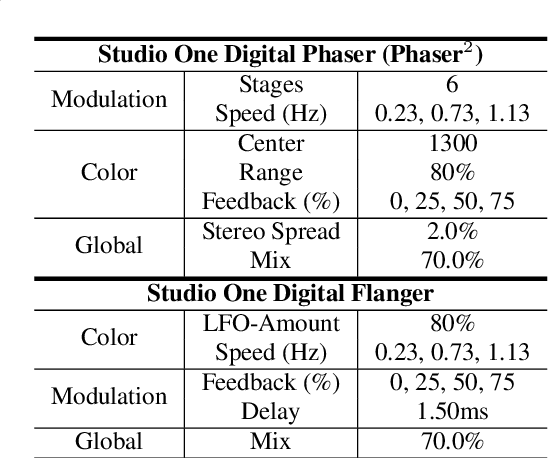
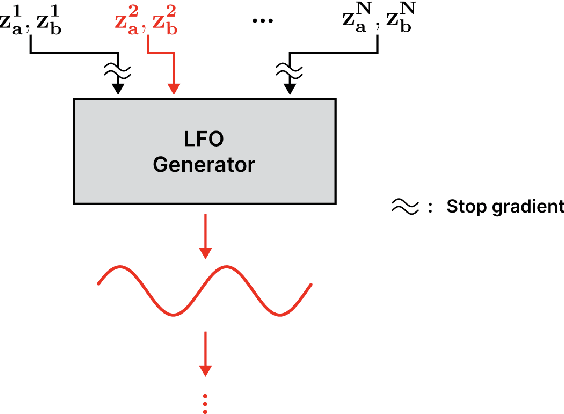
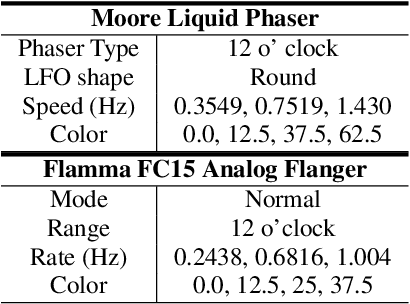
Abstract:Deep learning models have seen widespread use in modelling LFO-driven audio effects, such as phaser and flanger. Although existing neural architectures exhibit high-quality emulation of individual effects, they do not possess the capability to manipulate the output via control parameters. To address this issue, we introduce Controllable Neural Frame-based Modulation Effects (CONMOD), a single black-box model which emulates various LFO-driven effects in a frame-wise manner, offering control over LFO frequency and feedback parameters. Additionally, the model is capable of learning the continuous embedding space of two distinct phaser effects, enabling us to steer between effects and achieve creative outputs. Our model outperforms previous work while possessing both controllability and universality, presenting opportunities to enhance creativity in modern LFO-driven audio effects.
Correlation of Fréchet Audio Distance With Human Perception of Environmental Audio Is Embedding Dependant
Mar 26, 2024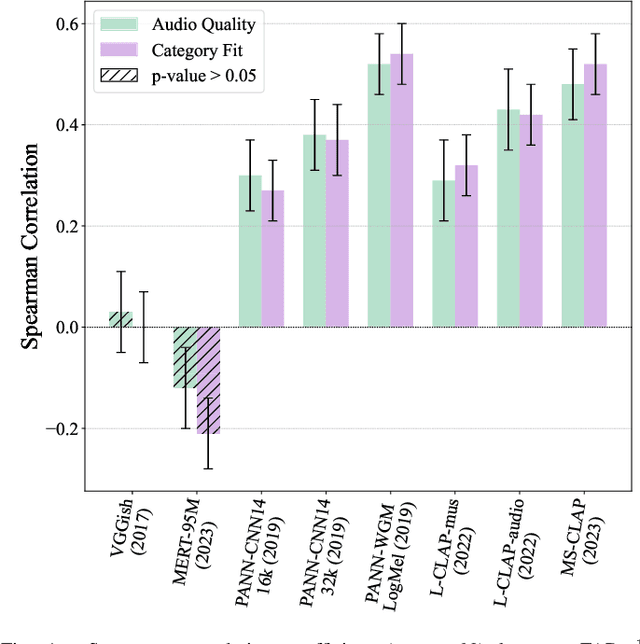
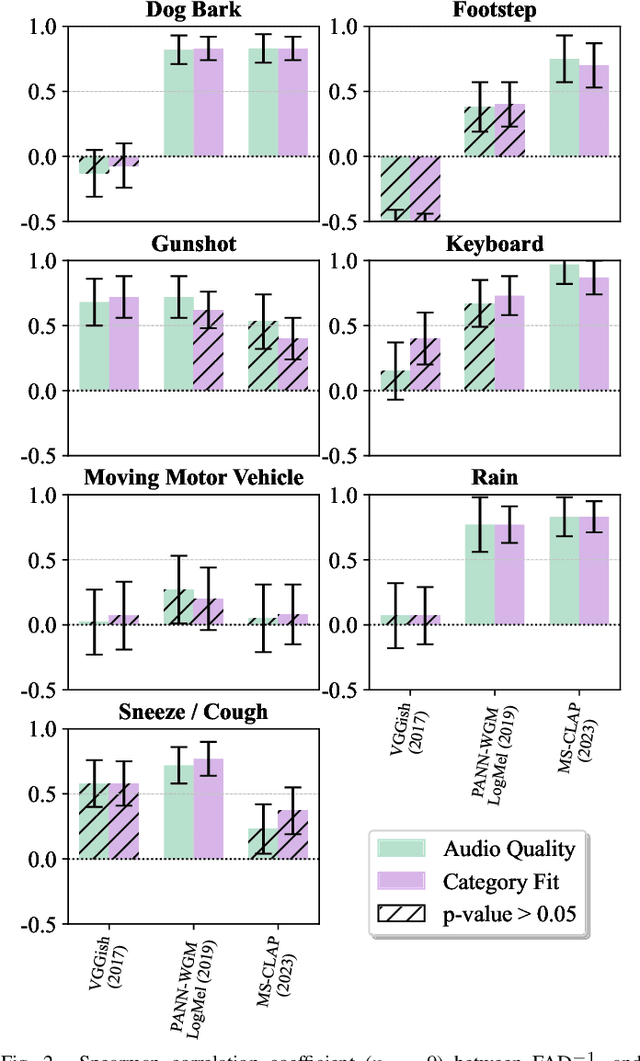

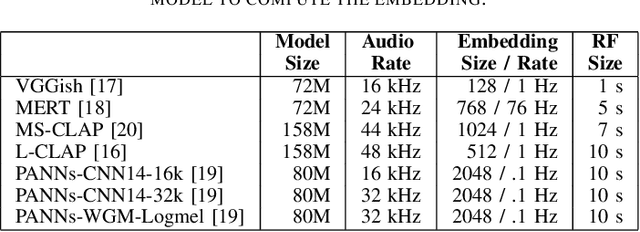
Abstract:This paper explores whether considering alternative domain-specific embeddings to calculate the Fr\'echet Audio Distance (FAD) metric can help the FAD to correlate better with perceptual ratings of environmental sounds. We used embeddings from VGGish, PANNs, MS-CLAP, L-CLAP, and MERT, which are tailored for either music or environmental sound evaluation. The FAD scores were calculated for sounds from the DCASE 2023 Task 7 dataset. Using perceptual data from the same task, we find that PANNs-WGM-LogMel produces the best correlation between FAD scores and perceptual ratings of both audio quality and perceived fit with a Spearman correlation higher than 0.5. We also find that music-specific embeddings resulted in significantly lower results. Interestingly, VGGish, the embedding used for the original Fr\'echet calculation, yielded a correlation below 0.1. These results underscore the critical importance of the choice of embedding for the FAD metric design.
T-FOLEY: A Controllable Waveform-Domain Diffusion Model for Temporal-Event-Guided Foley Sound Synthesis
Jan 17, 2024Abstract:Foley sound, audio content inserted synchronously with videos, plays a critical role in the user experience of multimedia content. Recently, there has been active research in Foley sound synthesis, leveraging the advancements in deep generative models. However, such works mainly focus on replicating a single sound class or a textual sound description, neglecting temporal information, which is crucial in the practical applications of Foley sound. We present T-Foley, a Temporal-event-guided waveform generation model for Foley sound synthesis. T-Foley generates high-quality audio using two conditions: the sound class and temporal event feature. For temporal conditioning, we devise a temporal event feature and a novel conditioning technique named Block-FiLM. T-Foley achieves superior performance in both objective and subjective evaluation metrics and generates Foley sound well-synchronized with the temporal events. Additionally, we showcase T-Foley's practical applications, particularly in scenarios involving vocal mimicry for temporal event control. We show the demo on our companion website.
A Novel Patent Similarity Measurement Methodology: Semantic Distance and Technological Distance
Mar 23, 2023Abstract:Measuring similarity between patents is an essential step to ensure novelty of innovation. However, a large number of methods of measuring the similarity between patents still rely on manual classification of patents by experts. Another body of research has proposed automated methods; nevertheless, most of it solely focuses on the semantic similarity of patents. In order to tackle these limitations, we propose a hybrid method for automatically measuring the similarity between patents, considering both semantic and technological similarities. We measure the semantic similarity based on patent texts using BERT, calculate the technological similarity with IPC codes using Jaccard similarity, and perform hybridization by assigning weights to the two similarity methods. Our evaluation result demonstrates that the proposed method outperforms the baseline that considers the semantic similarity only.
Music Playlist Title Generation Using Artist Information
Jan 14, 2023Abstract:Automatically generating or captioning music playlist titles given a set of tracks is of significant interest in music streaming services as customized playlists are widely used in personalized music recommendation, and well-composed text titles attract users and help their music discovery. We present an encoder-decoder model that generates a playlist title from a sequence of music tracks. While previous work takes track IDs as tokenized input for playlist title generation, we use artist IDs corresponding to the tracks to mitigate the issue from the long-tail distribution of tracks included in the playlist dataset. Also, we introduce a chronological data split method to deal with newly-released tracks in real-world scenarios. Comparing the track IDs and artist IDs as input sequences, we show that the artist-based approach significantly enhances the performance in terms of word overlap, semantic relevance, and diversity.
Music Playlist Title Generation: A Machine-Translation Approach
Oct 03, 2021



Abstract:We propose a machine-translation approach to automatically generate a playlist title from a set of music tracks. We take a sequence of track IDs as input and a sequence of words in a playlist title as output, adapting the sequence-to-sequence framework based on Recurrent Neural Network (RNN) and Transformer to the music data. Considering the orderless nature of music tracks in a playlist, we propose two techniques that remove the order of the input sequence. One is data augmentation by shuffling and the other is deleting the positional encoding. We also reorganize the existing music playlist datasets to generate phrase-level playlist titles. The result shows that the Transformer models generally outperform the RNN model. Also, removing the order of input sequence improves the performance further.
 Add to Chrome
Add to Chrome Add to Firefox
Add to Firefox Add to Edge
Add to Edge